
- TOP CATEGORIES
- AS and A Level
- University Degree
- International Baccalaureate
- Uncategorised
- 5 Star Essays
- Study Tools
- Study Guides
- Meet the Team

AS and A Level: Comparative Essays
- English Literature
- Comparative Essays

"English poets are being forced to explore not just the matter of England, but what is the matter with England" (Seamus Heaney) - Discuss.
"English poets are being forced to explore not just the matter of England, but what is the matter with England" (Seamus Heaney). Discuss. It is an inevitable fact that the consumers of literature - laymen and literary critics alike - tend to group together texts and authors into separate categories, and attach to each category a number of supposedly 'common' characteristics and idiosyncracies which all its members apparently share. Philip Larkin and Ted Hughes, and their poetry, are no exceptions. Larkin and Hughes are often linked together when discussing English poets, and do have a number of things in common: they were born within eight years of each other, they wrote and published their poetry at similar times, and both are identified with the north of England. Both men were writing at a time when the notion of a stable and established England was being undermined, largely due to the rapid social change initiated by the termination of the Second World War. Thus both poets were heirs to a unique poetic impulse which sought to reject the old order of modernism by employing creative and innovative forms of expression: the new consciousness of a new generation. Yet although Larkin and Hughes are frequently grouped together as 'English post-war poets', a term which suggest homogeneity, there is in reality more diversity in their approaches than is commonly assumed.
- Word count: 3208
- Level: AS and A Level
- Subject: English

Compare the two poets Ted Hughes and Simon Armitage.
Compare the two poets Ted Hughes and Simon Armitage In the untitled poem by Simon Armitage, the poem describes to us a short story that happened many years ago. The story is of a 13-year-old boy during puberty, and not knowing how to deal with his feelings for a girl in his class. The boy heated up scissors in a flame in a chemistry lab and then handed them to the girl marking rings around her fingers. We presume that the boy in the story is the poet, Simon Armitage as the poem is written in 1st person. The poet now feels a little sorry for what he did but tries to excuse it using the sentence, '...that was just my butterfingered way, at 13 of asking you to marry me.' In this quote he tries to use his age as an excuse as he was only young. The poet telling the story does not actually say that he is sorry but we get that impression from the quote, 'Don't believe me, please, if I say...' when the poet was 13 though we get a different opinion of what he was feeling, we get the impression that he felt amused, proud and triumphant of what he had done, but know looking back does not feel the same as he did. I believe that the overall message of the poem is to ask the girl that he burnt at 13 to marry him; he tries to excuse what he did and then goes on to say; 'Don't believe me please, if I say, that was just my butterfingered way, at 13 of asking you to marry me.' I believe
- Word count: 1817

Comparing and analysing Heaney's 'Blackberry Picking' and Plath's 'Blackberrying.'
Comparing and analysing Heaney's 'Blackberry Picking' and Plath's 'Blackberrying.' In this essay I shall compare these two poets by studying one poem by each of them and analysing the different literary devices used. Both 'Blackberry picking' and 'Blackberrying' contain strong and powerful uses of imagery. Blackberrying is the first poem, which I shall be studying. It begins, again, rather dully and yet brings across more of a scenic image. "Nobody in the lane, and nothing, nothing but blackberries." Obviously this opening line is trying to show a picture of large numbers of blackberries, but notice how she emphasises the negatives as though it is the fact that here are no forms of life around which she is enjoying and not the blackberries. The first image, which she writes of 'A Blackberry alley, going down in hooks', this, is quite a sinister image for each to start. The second image, which she writes of, is that of the size of the berries "big as the ball on your thumb" but she then adds to this by saying the berries are "dumb as eyes." This is an interesting image to be putting to the reader for she is mixing the senses suggesting that the berries have eyes. However this does not bother her because unlike people the berries cannot speak to her or harm her in any way. She moves on from this to include anthropomorphism by describing the berries as "fat", this is normal
- Word count: 1710

Compare and contrast Ulysses and The Love Song of J. Alfred Prufrock in their treatment of ageing and ambition
Compare and contrast Ulysses and The Love Song of J. Alfred Prufrock in their treatment of ageing and ambition The title of Eliot's poem initially suggests that it is not a traditional love poem at all. Eliot's choice to use the initial "J" instead of a first name implies a sense of importance, however Prufrock is a connotation of a "prude" in a "frock" which pokes fun at the pompous nature of the name and implies a subliminal other meaning to the name. Prufrock begins in the unpleasant modern world, which is comparable to "da Montefeltro" in Dante's "Inferno" being trapped in hell; however Prufrock is fixed in a lonely, isolating city. This reflects Prufrock's ambition, because he is insecure and feels as if he is trapped and cannot go anywhere. Eliot's imagery is extremely important in illustrating pieces of Prufrock's personality. He uses images of the city being bleak and frightening. The image of "the evening is spread out against the sky like a patient etherized upon a table" shows that Prufrock's view of the world is that it is bleak and empty. This also illustrates Prufrock's lack of ambition because it shows that he feels there is nothing good in the world worth trying for. Prufrock is afraid to speak to the women he sees because he thinks that he wont be able to say anything capable of making them become interested in him, and his overwhelming insecurity and fears
- Word count: 1287

Thomas hardy poem - neutral tones
Taking Neutral Tones as a starting point, discuss the emotions and reactions to love shown by Hardy in his poems about unrequited love as compared with the 1912-3 collection. You should view this as a chance to really hit AO5. I want lovers named and through circumstances of each discussed as fully as possible. Hardy's focus in many poems is around the subject of unrequited love and exhibits the emotions that are felt at that period of time. He also wrote a selection of poems called the 1912-13 collection, which focused on his first wife Emma and her death, however, these poems rarely talked about his love for her. It was mostly about blame or opportunities that he could have had with her but he had let pass. The theme of missed opportunities also runs through poems other than the 1912-13 collection. In Hardy's poem 'Neutral Tones', Hardy talks about a memory he has when he is 27 years old. This poem is a snapshot of a moment, where he recalls standing with his former young love by the side of a pond, in the middle of winter, 'we stood by a pond that winter day'. The unknown girl and Hardy are surrounded by dead landscape that acts as a metaphor for their emaciated relationship, 'the sun was white'. The white colour of the sun represents emptiness and lack of passion, the sun has been drained of its natural golden colour. Hardy uses pathetic fallacy in this metaphor to
- Word count: 990

How Do These Poems Reveal Shelley(TM)s Views About The Role Of The Poet?(TM) Discuss.
'How Do These Poems Reveal Shelley's Views About The Role Of The Poet?' Discuss. Throughout Shelley's poetry, the figure of the poet is displayed not just as an intelligent witty entertainer or an intellectual social observer but is in fact, a prophet. Shelley does not try to hide the fact he believes himself to be a prophet, a splendid soul with the divine gift to restore freedom to the people and bring justice to those who need it. Shelley felt that poets have a supreme connection with nature and with this connection are able to translate the 'cosmic truths' of the world into work for people to admire and act upon. Shelley was said to compare himself to Prometheus and even Jesus Christ in the sense that he, as a poet, was a prophet, whose duty it was to liberate the peoples of the world by perceiving the world around him and translating the 'messages' from nature to the general public who would, in turn, throw off the shackles of their oppressors and rise up. Shelley also felt that poets carry a burden, similar to Christ carrying the crucifix, as they are persecuted for their works and are often misunderstood. Evidence of this can be seen when studying Shelley's poetry as well as his life. Shelley uses nature as his primary source of poetic inspiration, which was typical of Romantic poets at the time. In such poems as "The Mask of Anarchy" (1819) and "Ode to the West
- Word count: 1162

Larkin often seems to criticise society. In the light of this statement, what connections have you found between the ways in which Larkin and Abse write about the society in which they live? In your response include at least two of Larkins
'Larkin often seems to criticise society'. In the light of this statement, what connections have you found between the ways in which Larkin and Abse write about the society in which they live? In your response include at least two of Larkin's poems. Larkin criticises society in many of his poems and also does it from a superior place in an attempt to distance him from the society which he criticises and this can be seen in Nothing To Be Said. On the other hand, Abse writes about society and community whilst he participates in it and is a part of it. Larkin tries to stunt and remove the parts of society he criticises whilst it is clear Abse attempts to preserve many of the positives in society, for example in The Story of Lazarus, a story that surrounds the optimistic tale of someone surviving something so horrific. Abse is also very proud of the society from which he grew for example he is proud of being Welsh. Larkin labels and stereotypes the working class with a superior view in Nothing To Be Said, for example in the first stanza he describes the working class as 'small-statured cross-faced tribes', giving the impression that he views the working class as poorly developed, and a sense of savagery and it is possible to assume that Larkin viewed them as not very intelligent also. In addition to this, the use of the word 'tribes' is particularly powerful and evokes this
- Word count: 847

Warning by Jenny Joseph and On Ageing by Maya Angelou
Warning by Jenny Joseph and On Ageing by Maya Angelou Warning by jenny joseph is a humorous way of looking towards old age. It is written as a monologue within which the poet describes how she will behave when she is an old woman. In The first stanza she talks about herself and lists all the things she will do when she is old. She says she will wear the colours purple and red which are significant in the fact that they are bright garish colours. The two colours clash with each other and would not be put together by someone who cares about keeping up their appearance. One of the main themes to this poem is the idea of rebelling against the way society expects you to behave and the idea of not conforming therefore she decides to deliberately make a statement with her appearance by wearing clashing colours to show rebellion against the idea of everyone looking the same- everyone conforming. This idea of rebellion is further emphasised when she says "I shall spend my pension on brandy... and say we've no money for butter". She has decided that she is going to be deliberately difficult and irresponsible. She is desperate to rebel against the norms of responsible adulthood and change the way she has always been " escape from the sobriety of my youth" . The acts she chooses are harmless and humorous and she will be likely to get away with them as people will think she is
- Word count: 1299

Compare the two "Wuthering Heights" poems by Sylvia Plath and Ted Hughes.
> Compare the two "Wuthering Heights" poems by Sylvia Plath and Ted Hughes. Poets Sylvia Plath and Ted Huges both wrote poems by the name 'wuthering heights'. Based on the book by Emily Bronte, Both poems are highly descriptive and try to capture the essence of the landscape about which they were written, both with very different effect. Ted Hughes Describes a vibrant landscape. He paints a picture of a wild but beautiful place leading to a very positive tone in his poem. Huges poem has an almost aspirational quality. He talks of Emily Bronte as if he, or his character, wishes to be just like her. This gives the poem a far more positive tone than that of Sylvia Plath. Plath creates a deeply depressing, almost disturbing tone through her use of description. This results in a far more negative feel about the poem. This negativity seems to reflect both the wildness of the landscape and also her feelings. Huges uses his poem to tell a story that puts the reader in the position of the character in the poem. This leads to the reader feeling like a part of the poem, therefore creating a personal interest in the surroundings, which are described to them. The poem seems to be about more than just the landscape. It is about beginning to understand the book by Emily Bronte and in doing so understand the moor itself. Plath on the other hand uses her poem as a metaphor for her
- Word count: 1016

George and Lennie- COmparison and Contrast
David Urlanda George and Lennie (Comparison and Contrast) In the novel Of Mice and Men, the main characters George and Lennie were brought up closed to us. Through the first several pages of the book, these two characters were visualized. "George was small and quick, dark of face, with restless eyes and sharp, strong features. Every part of him was defined: small, strong hands, slender arms, a thin body and nose." While Lennie the opposite of George, "is a huge man, shapeless of face, with large pale eyes and with sloping shoulders." John Steinbeck describes these two characters as the opposite of each other. He describes Lennie as big man who thinks just like a child, and George as a small and a strong man. Steinbeck differentiates George and Lennie from each other on their mental and physical appearance and strength, George a small man and his opposite Lennie a huge man. In their physical appearance George was visualized with defined body parts and with strong features while Lennie with a shapelss face. In terms of mental ability, Steinbeck said that Lennie has a mild mental disorder that made him the weakest character in the novel. While George, compared to Lennie, he is the boss, he decides on everything they will do and Lennie depends on what he say. George and Lennie traveled together, since Lennie's Aunt Clara died. They are both migratory workers seeking
- Word count: 638
Other great essays

A Comparison Of 'Dulce Et Decorum Est' And 'Suicide In The Trenches'

Presentation of Suffering in Dulce et Decorum est and The Sentry

Compare and contrast 'MCMXIV' by Philip Larkin and 'Six Young Men' by Ted H...

- Fewer than 1000 75
- 1000-1999 131
- 2000-2999 19
Teacher Reviews
- 1 or more reviews 4
Peer Reviews
How to Write an Essay Comparing Poems
This is Revision World’s guide on how to write an essay or answer an exam question that asks you to compare poems within the poetry anthology you are studying.
Understanding the Task:
Identify the Key Components: Ensure you understand the task requirements, including the poems you're comparing, the themes, and the aspects you need to analyse (e.g., structure, language, tone).
Pre-Writing Stage:
Read and Annotate: Read the poems multiple times, annotating key themes, literary devices, and interesting observations.
Identify Similarities and Differences: Note down similarities and differences in themes, imagery, language, structure, and tone between the two poems.
Structuring Your Essay:
Introduction:
Introduce the poems and poets, providing context if necessary.
Present your thesis statement, outlining the main points of comparison.
Body Paragraphs:
Topic Sentences: Start each paragraph with a clear topic sentence that states the aspect of comparison.
Comparison: Analyse each poem separately, focusing on the chosen aspect (e.g., theme, structure). Then, compare and contrast the same aspect in both poems.
Use of Evidence: Provide evidence from the poems to support your analysis (quotations).
Analysis: Interpret the significance of the similarities and differences, considering their effects on the reader and the overall meaning of the poems.
Conclusion:
Summarise your main points of comparison.
Reflect on the significance of the comparisons and their implications for the reader.
Offer insights into the broader themes or messages conveyed by the poems.
Writing Tips:
Be Specific: Avoid vague statements and ensure your comparisons are specific and well-supported by evidence.
Consider Poetic Devices: Analyse the poets' use of poetic devices (e.g., imagery, symbolism, metaphor) and how they contribute to the overall effect of the poems.
Focus on Key Themes: Choose a few key themes or aspects to compare rather than attempting to cover everything in the poems.
Maintain Coherence: Ensure your essay flows logically, with clear transitions between paragraphs and ideas.
Proofread: Carefully proofread your essay for grammar, spelling, and punctuation errors.
Example Statement:
"In 'Poem A' and 'Poem B,' both poets utilise imagery and symbolism to explore the theme of loss, but while 'Poem A' uses natural imagery to convey a sense of grief and acceptance, 'Poem B' employs religious symbolism to depict a more existential struggle with loss and faith."
Example Topic Sentences:
"In 'Poem A,' the poet employs vivid natural imagery to convey the speaker's emotional response to loss."
"Conversely, 'Poem B' utilises religious symbolism to explore the theme of loss in a more abstract and existential manner."
By following these steps and incorporating these tips, you can effectively write a well-structured and insightful essay comparing two poems in your GCSE English Literature exam.

- Primary Hub
- Art & Design
- Design & Technology
- Health & Wellbeing
- Secondary Hub
- Citizenship
- Primary CPD
- Secondary CPD
- Book Awards
- All Products
- Primary Products
- Secondary Products
- School Trips
- Trip Directory
- Trips by Subject
- Trips by Type
- Trips by Region
- Submit a Trip Venue
Trending stories

Top results

- How To Write The Perfect Comparative Essay On Poetry
Poetry comparison – How to write the perfect comparative essay

When it comes to poetry analysis, Phil Beadle knows what examiners want to see – and he’s here to make sure you can help every student can deliver it

Poetry comparison – or writing a comparative essay about two poems, seen or unseen – is what students will eventually be assessed on when they come to sit the poetry analysis part of their English Literature GCSE .
It makes sense, therefore, to get some early poetry comparison practice in. See what the assessment criteria will be asking for in preparation for the day the stakes are high.
The first door we must knock on is the one housing the crone of context. What the GCSE mark schemes will eventually ask for is a well constructed, conceptual response replete with oodles of subject terminology and a fairly deep mention of context.
It asks students to do this, however, in very little time. It also ignores the fact that contextual analysis in poetry – aside from the obvious modern/ancient dichotomy – is a rich brew that requires, firstly, a lot of contextual knowledge.
Also ignored is the fact that the biographical takes you away from the textual. Since the value in poetry analysis is the study of how words and form align to construct beauty or its antithesis, mention of context inevitably takes you into the realms of history. This is a whole other subject.
Poetry comparison example
Resources: ‘My Last Duchess’, by Robert Browning ‘Remains’, by Simon Armitage
Context – theme
So, my recommendation to students when constructing the first paragraph of a poetry comparison essay is, if appropriate, to make glancing reference to the titles. Only go so far as linking these to comparison of theme. The contextual is in the thematic.
On comparing theme, they should make explicit reference to the word ‘subtextual’. This flags to the examiner that this is an answer rich in apposite use of subject terminology quite early on. For example:
“The subtextual theme of ‘My Last Duchess’ is that sexual jealousy can cause the empowered (in this case titled) men – or, indeed, just men – to so lose their minds. They become murderous. Whereas the subtextual theme of ‘Remains’ links to the ambiguities of the title.
“As a noun, it links to the idea of the human remains of the looter around which the narrative revolves. As a verb, all that is left is memory.
“Both these poems linger around ideas of memory. Both narrators are tortured. But whereas the narrator in ‘Remains’ realises that he is stained by his actions, the narrator of ‘My Last Duchess’ is oblivious and has learned altogether nothing.”
Structure – rhyme
This is as far as we might want to go with context. Otherwise, we are addressing the poetic with its opposite and scribing a list of dates.
So, the next paragraph should examine structure. We do so by using rhyme scheme and form as a way of unlocking it. First of all, say what you see and, where possible, state the form:
“‘My Last Duchess’ is from Browning’s collection of ‘Dramatic Monologues’. It’s a substantial block of text with one person, the Duke, speaking. ‘Remains’ is seven quatrain stanzas and a couplet.”

Analysis of rhyme scheme
This is simple to do and gives students an opportunity to shovel a bit of subject terminology the examiners’ way. Generally, it is best to leave this unanalysed however. This is because analysis of rhyme scheme is much richer in terms of unlocking structure.
“The rhyme scheme in ‘My Last Duchess’ is in perfect couplets. On the other hand, ‘Remains’ is the epitome of deliberate irregularity.
“If one is to take this as a symbolic suggestion of the degree of order in both dramatic and moral worlds, one might conclude that the world of the former poem is ordered and correct, whereas that of the latter is chaotic and incongruent.
“There is an irony in the Duke speaking in perfect rhyme, being able to rhyme “munificence” and “pretence” and then suggesting he has no “Skill in speech”. This suggests him to be the liar he is.
“But the more interesting approach is in ‘Remains’: three out of four of the end words in stanza one, in which the looters raid the bank, are repeated in stanza six, when the incident is replayed in the narrator’s memory.
“The fact that only three of the four words -“out”, “bank”, “not” – are repeated suggests the decay of memory. Internal rhyme also plays a part in the pivot between action turning into memory. The fourth stanza features eye rhymes ”agony”, “by”, “body” before going into near perfect rhyme that carries on into the next stanza, “lorry”, “really”.
“But “really” is an add on, a coda to the phrase “End of story”. It suggests that the death of the looter should have been the finish of the event, but that there is an unpleasant coda. This is the fact that memory ‘remains’.”
You can get a lot from a poem through examining the rhyme in detail.
Metre – stress
From there, we go onto a fairly stunted form of metrical analysis; and we do this precisely because others avoid it.
I am not suggesting that students attempt analysis of trochees and anapests. After all, to our modern untrained ears, the differences between stressed and unstressed syllables can be unfathomable.
But where there is obvious metric change, we take this as a signal from the poet to pay special attention to this line (and to analyse it).
“ Metrically, ‘My Last Duchess’ appears to be in tetrameter with the odd substitution, “I call”. This, again, might be taken to suggest the narrator’s level of control over his circumstances.
“ The metre in ‘Remains’ is used to create specific effects. It is broadly irregular except in stanzas one, three and six (even, event, recall) where it goes into tetrameter.
“ The substitutions on “Sleep” and “Dream”, however, give a jarring effect, an elongated stutter, a metric pause. This sets up the brief moment of peace before the nightmare of replayed events comes back to haunt him.”
Language – reflections
We do not go over the top with metrical analysis. Just one comparison is enough to let the examiner know we are on top of the brief.
“We do not go over the top with metrical analysis”
From there, we divert into the linguistic. Show the examiner that you can recognise the idea that the soundtrack of the poem is somehow a representation or mirror of the poem’s themes. One killer comparison is all we need:
“Ultimately, the distinction is between a narrator rich in self delusion and one haunted by self knowledge. Both are murderers, but one has no guilt over an action he considered before committing. The other took a rapid action that now haunts him.
“The difference in consideration is signalled by the punctuation. There is a difference between the time implied by the commas in “probably armed, possibly not” and the semi colons in “This grew; I gave commands; then all smiles stopped together”.
“It tells us much about their comparative level of ruthlessness and design at the moment of decision. There is also a distinction in maturity that is signalled by the howling childishness of the ‘oo’ sounds in “forsooth”, “choose” and “stoop” and the deadening emotional stutter of pain in the repetitive ‘n’ sounds in the penultimate line of ‘Remains’.”
And as for conclusions for your comparisons in poetry essay, don’t bother. We haven’t got the time, and they are always rubbish anyway.
Phil Beadle is a teacher and the author of several books. This includes Rules for Mavericks: A Manifesto for dissident creatives (Crown House). Check out our AQA English Literature Paper 1 revision resource .
Sign up to our newsletter
You'll also receive regular updates from Teachwire with free lesson plans, great new teaching ideas, offers and more. (You can unsubscribe at any time.)
Which sectors are you interested in?
Early Years
Thank you for signing up to our emails!
You might also be interested in...

Why join Teachwire?
Get what you need to become a better teacher with unlimited access to exclusive free classroom resources and expert CPD downloads.
Exclusive classroom resource downloads
Free worksheets and lesson plans
CPD downloads, written by experts
Resource packs to supercharge your planning
Special web-only magazine editions
Educational podcasts & resources
Access to free literacy webinars
Newsletters and offers
Create free account
By signing up you agree to our terms and conditions and privacy policy .
Already have an account? Log in here
Thanks, you're almost there
To help us show you teaching resources, downloads and more you’ll love, complete your profile below.
Welcome to Teachwire!
Set up your account.
Lorem ipsum dolor sit amet consectetur adipisicing elit. Commodi nulla quos inventore beatae tenetur.
I would like to receive regular updates from Teachwire with free lesson plans, great new teaching ideas, offers and more. (You can unsubscribe at any time.)
Log in to Teachwire
Not registered with Teachwire? Sign up for free
Reset Password
Remembered your password? Login here

Poetry & Poets
Explore the beauty of poetry – discover the poet within
How To Start A Poetry Comparison Essay
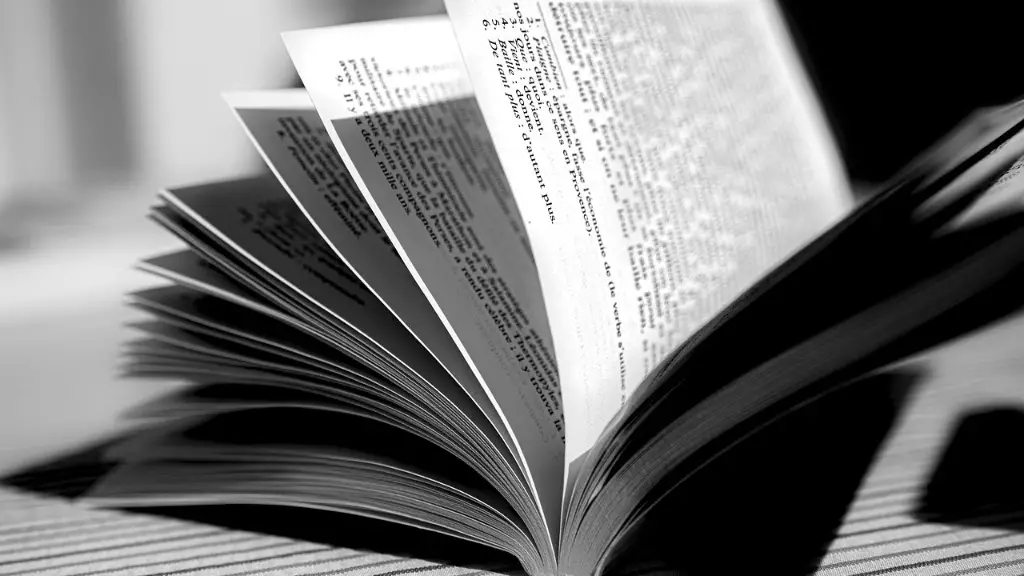
Have you been asked to write a poetry comparison essay? Are you at a loss for where to start? If this is the case, then you have come to the right place. In this article, we will walk you through the steps of how to start a poetry comparison essay.
One of the first things that you need to do is to familiarize yourself with the writings of the two poets that you have chosen to compare. Read their works carefully and look for common themes, styles, and imagery. Make sure to also remember to identify any differences that you find as well. This will help you when it comes to writing your essay as you will be able to identify both the similarities and the differences in the two poets’ styles and compare them.
Next, you must decide on the structure and the flow of your essay. An effective way to do this is to include an introduction, a main body, and a conclusion. The introduction is where you will introduce the two poets and give a brief explanation of the topic. In the main body, discuss the different aspects of the two poets’ works that you have identified and how they compare to one another. Lastly, the conclusion is where you can summarize what you’ve discussed and point out any potential implications of your comparison.
Aside from the structure, it is important to also ensure that your essay is well organized. This means that, within each section, all of the ideas are related and they lead up to a conclusion. For example, when comparing two poems, you can start with the background of both authors, discuss the similarities and differences of their works, and then come to a final conclusion on the comparison. Proper organization of your essay will help to ensure that your points are clear and effective.

When comparing poetry, it is important to also consider the connotations and implications of the words that the poets have chosen to use. By examining the author’s word choice, you can gain further insight into their writing styles and compare the implications of their words. This will not only help you to gain further insight into their works, but it will also help to make your points more persuasive and effective.
Finally, in order to make your essay as effective and persuasive as possible, use evidence to back up your points. Ensure that the evidence you use is relevant to the point that you are trying to make. You can use citations to back up your arguments and make them more compelling. In addition, use rhetorical questions to engage the reader and encourage them to think more deeply about the topics discussed in your essay.
These are just some of the tips that can help you to write an effective and persuasive poetry comparison essay. Remember to start by familiarizing yourself with the works of the two poets, and then move onto organizing your essay. Consider the implications of the words that the poets have used and use evidence to back up your points. By following these tips, you will be sure to write a great essay.
Researching Poetry
When working on a poetry comparison essay, it is important to research the works of both poets thoroughly. Look for common themes, literary techniques, and imagery used in both poets’ works. This will help you to better understand their works and compare them effectively. Additionally, you should also research the life and times of both authors. This will help you understand context, which is important for interpreting the poets’ works.

When researching, it may be helpful to use online resources such as poetry databases, websites dedicated to the works of individual poets, and academic journals. Additionally, scholarly books on either of the two poets may also be useful. These resources may provide useful information about both poets and help you to better compare their works.
In addition, there may also be some primary source material available about the two poets, such as interviews with the authors, manuscripts, letters, diaries, and recordings. Accessing such material can help you to gain an even deeper understanding of both writers’ works.
Analyzing Poetry
Once you have a thorough understanding of the two poets’ works, you must analyze them in order to write an effective comparison essay. Be sure to look for all the relevant similarities and differences between the two writers. Additionally, you should look for any motifs or symbols used by both poets and consider how they interact with each other. Also, consider the implications and connotations of the words used by both authors.
Another important aspect of analyzing poetry is to consider the themes of each poem. In most cases, a poem will explore a theme, or message, the author is trying to convey. By examining the topics explored and the tones used in each poem, you can get an insight into the meaning of the poems and better compare them.
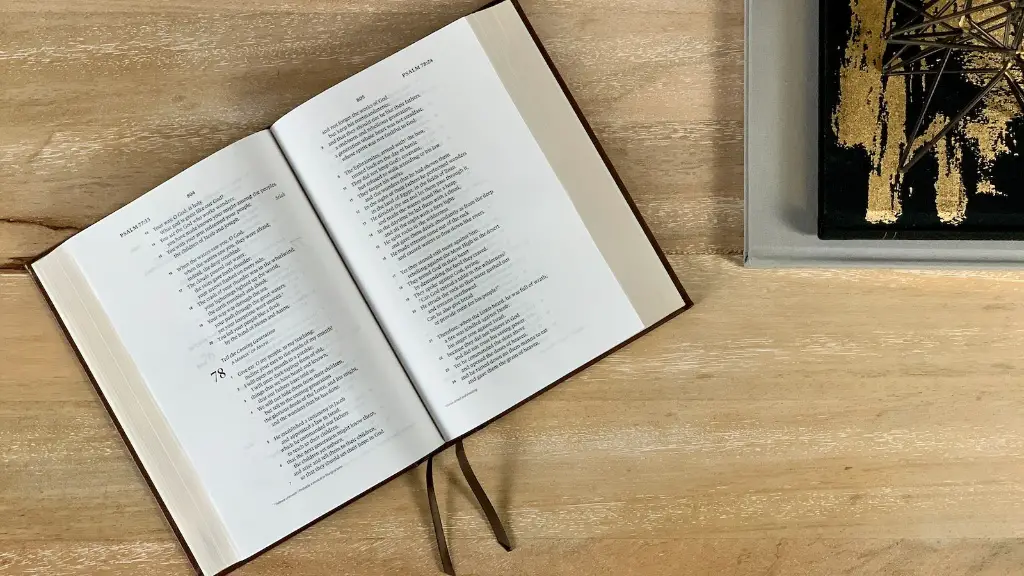
Finally, also look out for any literary techniques used by the poets. For example, consider word choice and sentence structure, meter, and rhyme. All of these techniques can paint a picture of the poem’s meaning and give you a better idea of how to compare the two poets’ works.
Writing Tips
As with any other essay, it is important to ensure that your poetry comparison essay is well written. When writing your essay, be sure to use an active voice, concise and clear language, and texts. Do not use long, winding sentences and avoid the use of filler words. Additionally, ensure that your essay is clear and well structured. Use topic sentences to introduce each paragraph and be sure to connect each idea to the next in the essay.
It is also important to pay attention to grammar, punctuation, and spelling. Ensure that all of your sentences are correctly constructed and that all spelling errors are corrected. Also, use appropriate citations when necessary and be sure that all of the sources that you have used are properly attributed. This will not only make your essay more organized and effective, but it will also make your paper look more professional.
Remember to review your essay after you have finished writing it. Before submitting your paper, be sure to go through it and check for any errors. Pay attention to any typos, grammar mistakes, or missing information. Additionally, review the structure of your essay and ensure that all points flow logically and that the conclusion is consistent with the rest of the essay. Finally, make sure to double-check any information that you have used in your paper to ensure that it is accurate and up-to-date.

As you can see, writing a poetry comparison essay can be a challenging task. However, with proper preparation and organization, it is possible to write a great essay. Start by researching the works of both poets and conducting a thorough analysis. Once you have done so, it is time to begin writing your essay. Use all of the aforementioned tips to ensure that your paper is well written and persuasive. And don’t forget to review your paper before submitting it!

Minnie Walters
Minnie Walters is a passionate writer and lover of poetry. She has a deep knowledge and appreciation for the work of famous poets such as William Wordsworth, Emily Dickinson, Robert Frost, and many more. She hopes you will also fall in love with poetry!
Leave a Comment Cancel reply
susansenglish
What I love… Education based blog by @susansenglish
Why I love…An A Level Unseen Poetry Essay Structure
I’m tutoring a student for A Level English Literature, which is brilliant, as I love teaching A Level and my student is hugely enthusiastic and really listens and adapts her ideas/thinking/approaches (which is also brilliant).
We started by talking about the Assessment Objectives that underpin the essay criteria – A01 and A02 and discussed the way that the question will be framed and how this is very ambiguous:
In your response you are required to analyse how meanings are shaped.
(choice of two poems)
Analyse in detail the following poem. (30 marks)
We decided the key here is the meaning and how that can be drawn out.
We looked at past examiner feedback that stated the key to understanding was reading the poem and re-reading. With this in mind we talked about timing:
Exam total – 2 hours
Unseen Prose – (50 marks) 1 hour 15 minutes
Unseen Poetry – (30 marks) 45 minutes
For the Poetry this then divides into – 10 minutes reading and planning a response (focusing on what the poem means) – 30 minutes writing – 5 minutes editing.
After discussing this we went through the planning process. We decided that due to the vagueness of the question, framing a question around the summary of meaning was a good approach, so that the essay was focused and could adopt a sophisticated approach.
We also discussed the essay structure and how the meaning would drive the overall number of paragraphs and how the meaning should be drawn out. For A Level, unlike GCSE we would be thinking about the paragraphs as an organic part of the writing, rather than trying to teach an overall structure. In this way, there is more freedom for the interpretation, at least that is the intent!
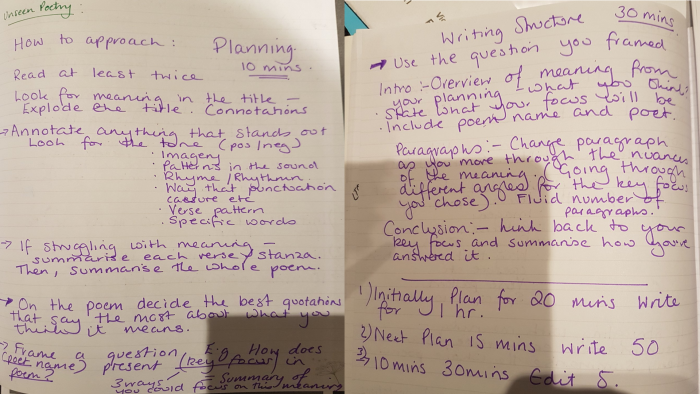
As you can see at the bottom of the poem, we discussed how to start planning to time. This was because we both annotated the same poem, using the planning notes from earlier.

At the end of the session, we both wrote an introduction thinking about the rules we’d explored previously and how this could support what we wanted to say in the essay.
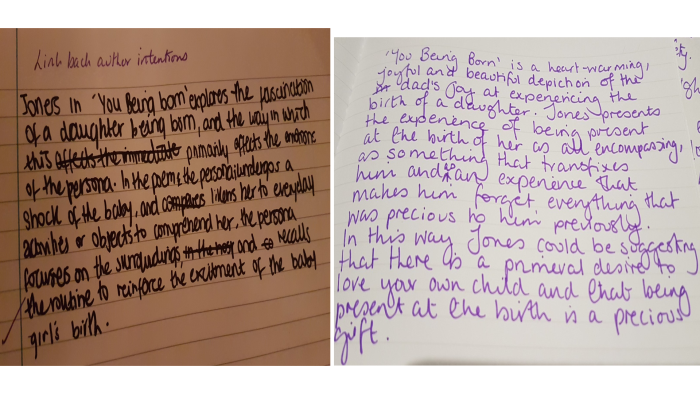
Both myself and the student had never studied the poem before. I used the wonderful @becky1820 (s) resources for this session, as she shared them with me, for the purpose of tutoring, and I only hope I’ve done them justice. The student will go on to write the essay independently and we’ll look at it together in another session.
**must work on my photography skills!
I hope that this is useful. I enjoyed the rich discussion around the process, the poem and just generally the love of the subject.
Share this:
7 thoughts on “ why i love…an a level unseen poetry essay structure ”.
Hi Susan, This is wonderful. I am tutoring A level literature too! So useful. Thank you! Sue x
Sent from my iPhone
Thanks a lot……… This really changed my motive toward answering questions in exam. Also planning to write A level exam this year and the fear is so much but u fixed Dat today.
Thanks Praise, glad you are feeling better about the exam.
Hello I am a year 13 student and i am interested in getting tutored. Is there any way i can contact you for further details.
Hello I am a year 13 student and i am interested in getting tutored. Is there any way i can contact you for further details. Thank You,my email is: [email protected]
- Pingback: Why I love… Revisiting my Unseen Poetry Approach – susansenglish
Leave a comment Cancel reply
Social menu.
- Why I love…Closed Book for GCSE Literature
- Why I love…How – What – Why – Emotional Response for Analysis
- Why I love…Law in R&J
- Why I love…Instructions
- Why I love… My Dad
- Why I love…Challenging perceptions of drugs with students
- Why I love…#Hay30
- Why I love…Just another lesson
- Why I love…Considering Evaluation Style Questions
- Why I love… Challenging Apathy
- Why I love… Writing at the same time as the class
- Why I love … Religion in A Christmas Carol
- Why I love…Engagement in Y13 & Hamlet Podcasting
- Why I love… The Power of Three for Revising
- Why I love… Going back to basics: Instructions
- Why I love… Shakespeare (& think teaching it is so important)
- Why I love…Promoting Analysis
- Why I love…Considering Leadership Qualities
- Why I love…Easter & reading: the Carnegie shortlist
- Why I love…Quizlet
- Why I love… Engaging Revision or ‘The Final Push’
- Why I love… Metacognitive Activities
- Why I love… Quick Revision Wins
- Why I love… Thinking about Transactional Writing
- Why I love…Podcasting with @ChurchillEng
- Why I love… #LeadPChat
- Why I love… Teaching Hamlet
- Why I love…Teaching (part 2)
- Why I love…collaborative Inset @NSTA
- Why I love… Developing 2A: Non-Fiction Reading Unit @Eduqas_English
- Why I love…Encouraging Revision @Eduqas_English
- Why I love…Twitter Revision
- Why I love… exploding an extract
- Why I love… teaching the Language Reading Paper
- Why I love… teaching Unseen Poetry
- Why I love… Assessment policy development for the New GCSE @Eduqas_English
- Why I love… Considering Context @Eduqas Poetry Anthology
- What I love… about unpicking the Eduqas Language Fiction Paper 1A (A4 & A5 Only)
- What I love… unpicking the Eduqas Language Fiction Paper 1A (A1 – A3 Only)
- Why I love…(d) #TLT16
- What I love… about #WomenEd
- Why I love… Quotations and Retention
- Why I love positive parental contact…
- Why I love collaboration in Year 13…
- Why I love our Eduqas revision site
- Why I love to read…
- Why I love A Level & AS Level results…
- Why I love thinking about classroom displays…
- Why I love collaborative working…
- Why I love summer…
- Why I love teaching…
- Why I love…CPD Feedback
- What I love… the little things
- Why I love… Training @Eduqas_English
- Why I love… #lovetoRead My Desert Island Books
- Why I love…teaching poetry
- Education Based blog
- Why I love…The A5 Fiction/A4 Non-Fiction Evaluation Question
- Why I Love…Blog Series 18: Mametz Wood By Sheers
- Why I love… Scaffolding the Tension and Drama – Structure Question for @Eduqas_English
- Why I love…Scaffolding: Language Analysis Questions
- Why I love…Blog Series: Introducing Context (War focus)
- Why I love…Scaffolding: Comprehension A1 Fiction Language @Eduqas_English
- Why I love…Blog Series 17: Ozymandias by Shelley
- Why I Love…Building Girls’ Confidence: My #WomenEdSW session
- Why I love…Strategies for stretch and challenge
- Why I love… Developing Analysis using Triplets
- Why I love…Blog Series 16: Dulce et Decorum Est by Owen
- Why I Love… Blog Series 15: Afternoons by Larkin
- Why I love… Vocabulary Improvement Strategies
- Why I love…Blog series 14: To Autumn by Keats
- Why I love…Embedding Knowledge Organisers into learning
- Why I love…Whole Class Feedback & Other Time-Saving Feedback Strategies
- Why I love…Blog Series 13: Hawk Roosting by Hughes
- What I love…Learning from #TLT
- Why I Love… Live Modelling for across the curriculum
- Why I love…(d) #TLT17 @TLT17
- Why I love…Blog Series 12: Death of a Naturalist by Heaney
- Why I love…Blog Series 11: A Wife in London by Hardy
- Why I love…Blog Series 10: Valentine by Duffy
- Why I love…Eduqas Blog Series 9: Cozy Apologia by Dove
- Why I love…Eduqas Blog Series 8: As Imperceptibly as Grief By Dickinson
- Why I love…Literature Examiner key considerations
- Why I love…Eduqas Anthology: Blog Series 7 Living Space by Dharker
- Why I love…Unpicking the Eduqas Examiners report – Literature
- Why I love…Unpicking the Eduqas Examiners report – Language
- Why I love…Eduqas Anthology: Blog Series 6 – She Walks in Beauty Byron
- Why I love…Eduqas Anthology: Blog Series 5 – The Soldier by Rupert Brooke
- Why I love…Eduqas Anthology: Blog Series 4 – London by Blake
- Why I love…Eduqas Anthology: Blog Series 3 Sonnet 43
- Why I love…Eduqas Anthology: Blog Series 2 – The Manhunt
- Why I love…Closed Book for GCSE Literature
- Why I love…How – What – Why – Emotional Response for Analysis
- Why I love…Law in R&J
- Why I love…Instructions
- Why I love… My Dad
- Why I love…Challenging perceptions of drugs with students
- Why I love…Considering Evaluation Style Questions
- Why I love…Engagement in Y13 & Hamlet Podcasting
- Why I love…Teaching
- Why I love thinking about classroom displays…
- Why I love A Level & AS Level results…
- Why I love to read…
- What I love… about unpicking the Eduqas Language Fiction Paper 1A (A4 & A5 Only)
- Why I love…teaching poetry
- Why I love…CPD Feedback
- What I love… the little things
- Why I love… Training @Eduqas_English
- Why I love…Twitter Revision
- Why I love…Teaching (part 2)
- Why I love… Teaching Hamlet
- Why I love…Podcasting with @ChurchillEng
- Why I love… Quick Revision Wins
- Why I love…Easter & reading: the Carnegie shortlist
- Why I love…Considering Leadership Qualities
- Why I love… Shakespeare (& think teaching it is so important)

- Already have a WordPress.com account? Log in now.
- Subscribe Subscribed
- Copy shortlink
- Report this content
- View post in Reader
- Manage subscriptions
- Collapse this bar
- International
- Schools directory
- Resources Jobs Schools directory News Search
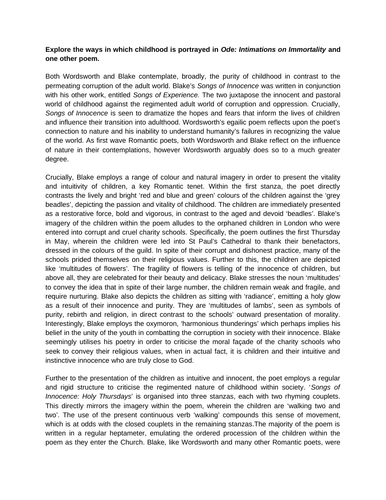
Edexcel English Literature A Level - Poetry Example Essays
Subject: English
Age range: 16+
Resource type: Assessment and revision
Last updated
25 March 2024
- Share through email
- Share through twitter
- Share through linkedin
- Share through facebook
- Share through pinterest

This is a document containing four example essays designed for Edexcel English literature A level.
Explore the ways in which childhood is portrayed in Ode: Intimations on Immortality and one other poem. (Romantics) Explore how death is presented in As The Cold Air Slept Below and one other poem. (Romantics) Compare the methods both poets use to represent Childbirth and Childhood. (Poems of the decade) Compare the methods both poets use to present and explore the nature of suffering. (Poems of the decade)
This resource is tailored for students who are studying the Romantics and poems of the decade.
For reference, I achieved an A* at A level.
Tes paid licence How can I reuse this?
Get this resource as part of a bundle and save up to 72%
A bundle is a package of resources grouped together to teach a particular topic, or a series of lessons, in one place.
English A Level Bundle - Edexcel
This document contains every English Literature resource I have uploaded to TES. The bundle contains resources for Hamlet, A streetcar named Desire, Wuthering Heights, A Thousand Splendid Suns, the Romantics and Poems of the Decade. For reference, I achieved an A* at A Level.
EDEXCEL A Level English Lit Poetry Bundle
This resource contains all the resources I have uploaded to TES concerncing the Edexcel A level poetry spec. I studied the Romantics and the Poems of the Decade spec. For reference, I achieved an A* at A level.
Your rating is required to reflect your happiness.
It's good to leave some feedback.
Something went wrong, please try again later.
This resource hasn't been reviewed yet
To ensure quality for our reviews, only customers who have purchased this resource can review it
Report this resource to let us know if it violates our terms and conditions. Our customer service team will review your report and will be in touch.
Not quite what you were looking for? Search by keyword to find the right resource:

IMAGES
VIDEO
COMMENTS
Example of a Poetry Comparison Essay. When writing a poetry comparison essay, an example can be useful. Taking a look at the following example from a student's A-Level English Literature essay: In this essay, I shall be comparing and contrasting two poems: "The Road Not Taken" by Robert Frost and "The Listeners" by Walter de la Mare.
https://goo.gl/qD2VMg to access super concise & engaging A-level videos by A* students for the AQA, OCR and Edexcel Specs.
However in structure B, the comparison takes place throughout the whole essay and avoids looking at the poems separately. This is a better model to use and one which can be applied to comparisons ...
Two Useful Mnemonics for a Poetry Essay: S.M.I.L.E. and F.I.E.L.D. A mnemonic is a familiar group of letters to help you memorise something through association with those letters. For example, to help you compare the poems and to write the essay, these two acronyms may come in handy: SMILE: Structure, Meaning, Imagery, Language, Effect
Compare the two poets Ted Hughes and Simon Armitage. Compare the two poets Ted Hughes and Simon Armitage In the untitled poem by Simon Armitage, the poem describes to us a short story that happened many years ago. The story is of a 13-year-old boy during puberty, and not knowing how to deal with his feelings for a girl in his class.
The comparative poetry aspect of the A level English Literature Edexcel exam can be quite tricky and in fact, if we look at the grade boundaries by unit we can see that the poetry paper has the lowest grade boundary of the whole spec. (41/60 for the A *).All to say, don't worry about finding this hard!The main thing to remember here is that you're trying to look for common ground between the ...
How should I write/approach an unseen poetry comparison essay? Poetry can be complicated and vague, with many subtle layers of meaning, but when you're writing an analytical response to it, you want to be clear, concise, and structured in your answers; especially since there will be someone ticking off criteria when reading your essay. Using ...
Main Paragraphs. Now, we come to the main body of the essay, the quality of which will ultimately determine the strength of our essay. This section should comprise of 4-5 paragraphs, and each of these should analyze an aspect of the poem and then link the effect that aspect creates to the poem's themes or message.
Topic Sentences: Start each paragraph with a clear topic sentence that states the aspect of comparison. Comparison: Analyse each poem separately, focusing on the chosen aspect (e.g., theme, structure). Then, compare and contrast the same aspect in both poems. Use of Evidence: Provide evidence from the poems to support your analysis (quotations).
Secondary English. Poetry comparison - or writing a comparative essay about two poems, seen or unseen - is what students will eventually be assessed on when they come to sit the poetry analysis part of their English Literature GCSE. It makes sense, therefore, to get some early poetry comparison practice in. See what the assessment criteria ...
All of these techniques can paint a picture of the poem's meaning and give you a better idea of how to compare the two poets' works. Writing Tips. As with any other essay, it is important to ensure that your poetry comparison essay is well written. When writing your essay, be sure to use an active voice, concise and clear language, and texts.
Edit: I made a prose version of this guide. Hi Following some discussion on the A-level English study group (which you should definitely join, by the way) I thought it might be helpful to show you how I write poetry essays. I'm going to be referring to a timed essay I wrote whose title was "Compare the methods the poets use to explore violence, death and the attitudes towards them." Of ...
For a coursework essay, you can take your time over this, and the same skills can be used to do the same thing efficiently in an exam. Step 1: READ!! Read the poems, and then read them again, and probably again just to be sure. Step 2: After reading through both poems thoroughly, you can make notes for each poem according to STRIP factors ...
The weightings for the Assessment Objectives in this question are: AO3 - 50%. AO4 - 25%. AO1 - 12.5%. AO5 - 12.5%. In simple terms, to achieve the highest marks (Level 6 = 26-30 marks), this means: AO3. Consider and incorporate a detailed discussion of the significance and influence of the contexts in which the texts were written and ...
With this in mind we talked about timing: Exam total - 2 hours. Unseen Prose - (50 marks) 1 hour 15 minutes. Unseen Poetry - (30 marks) 45 minutes. For the Poetry this then divides into - 10 minutes reading and planning a response (focusing on what the poem means) - 30 minutes writing - 5 minutes editing. Advertisement.
https://goo.gl/qD2VMg to access super concise & engaging A-level videos by A* students for the AQA, OCR and Edexcel Specs.
EDEXCEL A Level English Lit Poetry Bundle. This resource contains all the resources I have uploaded to TES concerncing the Edexcel A level poetry spec. I studied the Romantics and the Poems of the Decade spec. For reference, I achieved an A* at A level. was £7.00. This is a document containing four example essays designed for Edexcel English ...
But really, a good essay structure that you use all the time can be applied to a comparative essay too. So if you normally write 1) an intro 2) paras agreeing with the question 3) paras arguing against the question 4) a conclusion this could work here as well. Or you can find a new structure. The important thing is that you simply have to ...
The second question you'll answer on English Literature Paper 2 will be the poetry comparison question based on the Love and Relationships section of the AQA anthology. You have 1 hour 45 minutes for his paper so you should spend around 45 minutes on this question. You will be given the text of one poem which you must write about in your ...
Below you will find a full-mark, Level 6 model answer for an exam question. A commentary below the essay illustrates how and why it would be awarded Level 6. Despite the fact it is an answer to a specific past paper question, the commentary below is relevant to any unseen poetry comparison question.